Related Research Articles
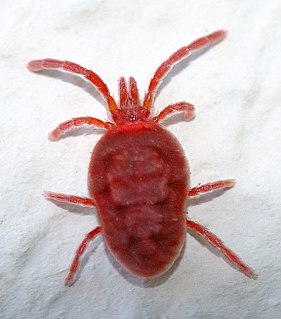
Mites are small arachnids.

Sarcoptes scabiei or the itch mite is a parasitic mite that burrows into skin and causes scabies. The mite is found in all parts of the world. Humans are not the only mammals that can become infected. Other mammals, such as wild and domesticated dogs and cats as well as ungulates, wild boars, bovids, wombats, koalas, and great apes are affected.
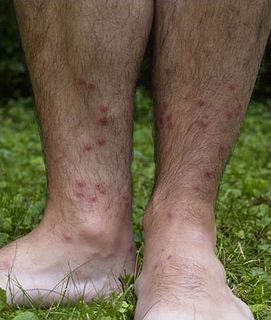
Swimmer's itch, cercarial dermatitis or schistosome dermatitis is a short-term allergic immune reaction occurring in the skin of humans that have been infected by water-borne schistosomes, a type of flatworms. It is common in freshwater, brackish and marine habitats worldwide. Incidence may be on the rise, although this may also be attributed to better monitoring. Nevertheless, the condition has been regarded as emerging infectious disease.

The codling moth is a member of the Lepidopteran family Tortricidae. They are major pests to agricultural crops, mainly fruits such as apples and pears. Because the larvae are not able to feed on leaves, they are highly dependent on fruits as a food source and thus have a significant impact on crops. The caterpillars bore into fruit and stop it from growing, which leads to premature ripening. Various means of control, including chemical, biological, and preventive, have been implemented. This moth has a widespread distribution, being found on six continents. Adaptive behavior such as diapause and multiple generations per breeding season have allowed this moth to persist even during years of bad climatic conditions.
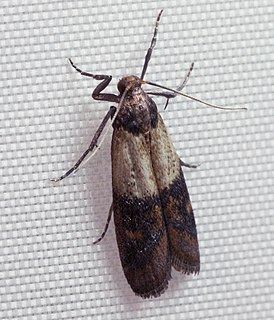
The Indianmeal moth, also spelled as Indian meal moth and Indian-meal moth, is a pyraloid moth of the family Pyralidae. Alternative common names are weevil moth, pantry moth, flour moth or grain moth. The almond moth and the raisin moth are commonly confused with the Indian-meal moth due to similar food sources and appearance. The species was named after being noted for feeding on Indian-meal or cornmeal and it does not occur natively in India as the aberrant usage of Indian meal moth would suggest. It is also not to be confused with the Mediterranean flour moth, another common pest of stored grains.
Acariasis is an infestation with mites.

The almond moth or tropical warehouse moth is a small, stored-product pest. Almond moths infest flour, bran, oats, and other grains, as well as dried fruits. It belongs to the family of snout moths (Pyralidae), and more specifically to the tribe Phycitini of the huge snout moth subfamily Phycitinae. This species may be confused with the related Indian mealmoth or the Mediterranean flour moth, which are also common pantry pests in the same subfamily.

The Mediterranean flour moth or mill moth is a moth of the family Pyralidae. It is a common pest of cereal grains, especially flour. This moth is found throughout the world, especially in countries with temperate climates. It prefers warm temperatures for more rapid development, but it can survive a wide range of temperatures.

The discipline of medical entomology, or public health entomology, and also veterinary entomology is focused upon insects and arthropods that impact human health. Veterinary entomology is included in this category, because many animal diseases can "jump species" and become a human health threat, for example, bovine encephalitis. Medical entomology also includes scientific research on the behavior, ecology, and epidemiology of arthropod disease vectors, and involves a tremendous outreach to the public, including local and state officials and other stake holders in the interest of public safety. Medical Entomologists are employed by private and public universities, private industries, and federal, state, and local government agencies, including all three branches of the US military - who hire medical entomologists to protect the troops from infectious diseases that can be transmitted by arthropods. Historically, during wars, more people have died due to insect-transmitted diseases, than to all the battle injuries combined.

Pyemotes herfsi, also known as the oak leaf gall mite or itch mite, is an ectoparasitic mite identified in Western Canada in 1923 and subsequently found in India, Asia, and the United States. The mite parasitizes a variety of insect hosts and bites humans, causing red, itchy, and painful wheals (welts). The mites are barely visible, measuring about 0.2-0.8 millimeters; their great reproductive potential, small size, and high capacity for dispersal by wind make them difficult to control or avoid.

Pyralis farinalis, the meal moth, is a cosmopolitan moth of the family Pyralidae. Its larvae (caterpillars) are pests of certain stored foods, namely milled plant products.

The flour mite, Acarus siro, a pest of stored grains and animal feedstuffs, is one of many species of grain and flour mites. An older name for the species is Tyroglyphus farinae.

Trombiculidae are a family of mites. Chiggers are often confused with jiggers - a type of flea. Several species of Trombiculidae in their larva stage bite their animal or human host and by embedding their mouthparts into the skin causing "intense irritation" or "a wheal, usually with severe itching and dermatitis",
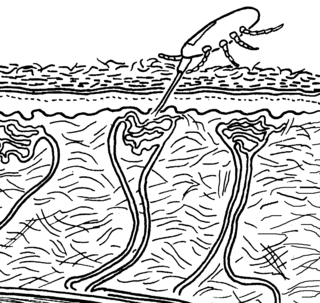
Gamasoidosis or dermanyssosis is a frequently unrecognized ectoparasitosis and source of growing concern in human medicine, occurring after contact with avian mites which infest canaries, sparrows, starlings, pigeons and poultry and caused by two genera of mites, Ornithonyssus and Dermanyssus. Avian mite species implicated include the red mite, tropical fowl mite and northern fowl mite . Mite dermatitis is also associated with rodents infested with the tropical rat mite, spiny rat mite and house-mouse mite, where the condition is known as rodent mite dermatitis. Urban gamasoidosis is associated with window-sills, ventilation and air-conditioning intakes, rooves and eaves, which serve as shelters for nesting birds. Humans bitten by these mites experience a non-specific dermatitis with intense itching.

Rhyzopertha is a monotypic genus of beetles in the family Bostrichidae, the false powderpost beetles. The sole species, Rhyzopertha dominica, is known commonly as the lesser grain borer, American wheat weevil, Australian wheat weevil, and stored grain borer. It is a beetle commonly found within store bought products and pest of stored cereal grains located worldwide. It is also a major pest of peanuts. The first documentation of wheat infestation by R. dominica was observed in Australia. R. dominica are usually reddish brown to dark brown in coloration, vary in sizes, elongated and cylindrical.

Pyroglyphidae is a family of non-parasitic mites. It includes the house dust mite that live in human dwellings, many species that live in the burrows and nests of other animals, and some pests of dried products stored in humid conditions.
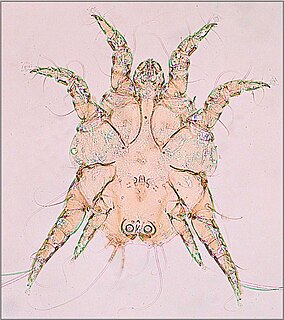
Mites that infest and parasitize domestic animals cause disease and loss of production. Mites are small invertebrates, most of which are free living but some are parasitic. Mites are similar to ticks and both comprise the order Acari in the phylum Arthropoda. Mites are highly varied and their classification is complex; a simple grouping is used in this introductory article. Vernacular terms to describe diseases caused by mites include scab, mange, and scabies. Mites and ticks have substantially different biology from, and are classed separately from, insects. Mites of domestic animals cause important types of skin disease, and some mites infest other organs. Diagnosis of mite infestations can be difficult because of the small size of most mites, but understanding how mites are adapted to feed within the structure of the skin is useful.
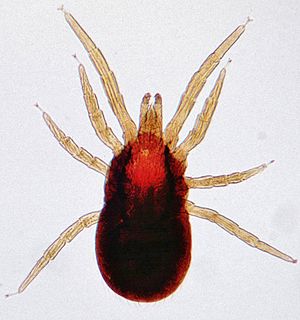
Mites are small crawling animals related to ticks and spiders. Most mites are free-living and harmless. Other mites are parasitic, and those that infest livestock animals cause many diseases that are widespread, reduce production and profit for farmers, and are expensive to control.
Rodent mite dermatitis is an often unrecognized ectoparasitosis occurring after human contact with haematophagous mesostigmatid mites that infest rodents, such as house mice, rats and hamsters. The condition is associated with the tropical rat mite, spiny rat mite and house mouse mite which opportunistically feed on humans. Rodent mites are capable of surviving for long periods without feeding and travelling long distances when seeking hosts. Cases have been reported in homes, libraries, hospitals and care homes. A similar condition, known as gamasoidosis, is caused by avian mites.

Pyemotidae is a family of mostly parasitic mites that feed on the larvae and other developmental stages of various insects but some species are herbivorous or fungivorous.
References
- ↑ OConnor, B.; Klimov, P. (30 April 2012). "Pyemotes tritici (LaGrèze-Fossat & Montagné, 1851)". UMMZ Insect Division. Retrieved 2 September 2018.
- 1 2 Berenbaum, May (1993). Ninety-nine More Maggots, Mites, and Munchers . University of Illinois Press. pp. 31–32. ISBN 978-0-252-06322-0.
- 1 2 3 4 Schuster, Reinhart (2012). The Acari: Reproduction, development and life-history strategies. Springer Science & Business Media. pp. 209–219. ISBN 978-94-011-3102-5.
- ↑ S. Rosen, I. Yeruham & Y. Braverman (2002). "Dermatitis in humans associated with the mites Pyemotes tritici, Dermanyssus gallinae, Ornithonyssus bacoti and Androlaelaps casalis in Israel". Medical and Veterinary Entomology . 16 (4): 442–444. doi:10.1046/j.1365-2915.2002.00386.x. PMID 12510897.